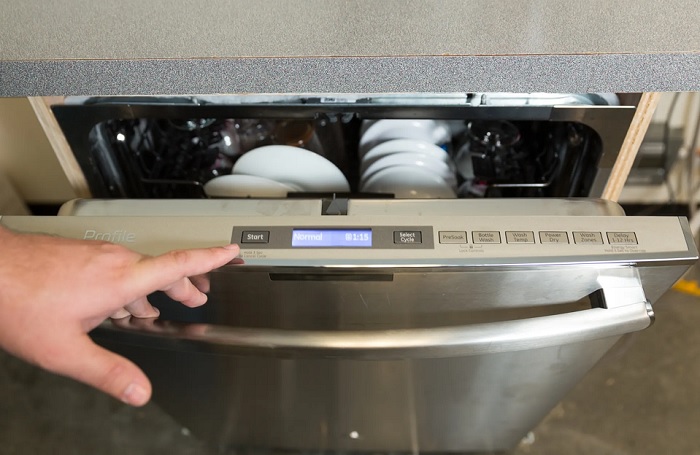The GE Dishwasher is one of the most reliable and portable brands on the market. It comes with a sleek, smooth look, and durable build that means you will get your money’s worth with the choice. Among its safety features is a thermal fuse that it ensure a simple power outage won’t mean getting an entirely new dishwasher.
If you’re having issues with your GE Dishwasher and you think the fuse is the problem, this article will guide you on how to find the fuse location, so you can diagnose any issues you may have.

GE Dishwasher Fuse Location: Step by Step
Finding the fuse in your GE dishwasher is the first thing to do when diagnosing and resolving electrical problems. Follow the step-by-step instructions below to locate the fuse:
- Prioritize safety: Always put your safety first when working with electrical appliances. Disconnect your dishwasher from the power supply by either switching off the circuit breaker or unplugging it from the electrical outlet. This will eliminate the risk of any electrical mishaps.
- Access the control panel: Open the dishwasher door and examine the top portion of the inner door frame. In most GE dishwasher models, you will find the control panel, which contains buttons and indicators for operation.
- Remove the control panel: Using a screwdriver, carefully unscrew the screws that secure the control panel to the inner door frame. Once the screws are removed, gently lift and tilt the control panel forward, revealing the internal components.
- Locate the fuse: Inside the control panel, you will find the fuse box. It is a small rectangular component that houses the fuse, which serves to protect the dishwasher’s electrical system from power surges and short circuits.
- The thermal fuse could also be located on the top side of the circuit board assembly. You will notice that there are two wires attached to it.
Common Problems Caused by a Faulty Fuse
Now that you have identified the fuse’s location, you might want to take a look at the problems that can arise due to a faulty fuse, so you can better understand if you really have a faulty fuse problem. Below are some common issues associated with a malfunctioning dishwasher fuse:
- Power failure: If your dishwasher suddenly stops working and shows no signs of power, a blown fuse could be to blame. A power surge or electrical overload can cause the fuse to blow, disrupting the flow of electricity to the dishwasher.
- Inoperative control panel: A faulty fuse can lead to a malfunctioning control panel. This may manifest as unresponsive buttons, erratic display, or complete failure of the control panel.
- Lack of water circulation: When the fuse blows, it can prevent the dishwasher from initiating the water circulation process. Also, you may observe that water fails to enter the dishwasher, hampering the cleaning cycle.
Solutions for Fixing Faulty Fuse Issues
When it comes to faulty fuse, you won’t have any problems getting a fix. Fortunately, resolving a faulty fuse issue in your GE dishwasher can be relatively straightforward. Follow the detailed steps below to fix the problem:
- Disconnect the power supply: You would want to ensure that the dishwasher is disconnected from the power source. Switch off the circuit breaker or unplug the appliance.
- Inspect the fuse: Locate the fuse within the fuse box in the control panel. Using a pair of pliers or your fingers, carefully remove the fuse. Examine it closely for any signs of damage, such as a broken filament or discoloration.
- Replace the fuse: If you find the fuse to be faulty, purchase a suitable replacement fuse from a reputable appliance parts store or directly from the manufacturer. Ensure that the replacement fuse matches the specifications of the original one.
- Install the new fuse: Insert the new fuse into the fuse holder within the fuse box. Make sure it is securely seated and properly installed.
- Reassemble the dishwasher: Gently reattach the control panel to the inner door frame, using the screws that were removed earlier to secure it in place.
- Power up the dishwasher: Restore power to the dishwasher by switching the circuit breaker back on or plugging it back into the electrical outlet.
- Test the dishwasher: Initiate a dishwasher cycle to confirm whether the fuse replacement has successfully resolved the issue. If the dishwasher functions normally, then you have effectively fixed the faulty fuse problem.
Conclusion
If power surges are a common occurrence in your area, then you would have to deal with a faulty fuse sooner or later. By getting to know the fuse location in your GE dishwasher and understanding the issues caused by a faulty fuse, you can easily troubleshoot and fix any related problems. The guide we’ve provided should make it easier for you to fix these issues without needing professional assistance.




![Keurig Not Working After Cleaning with Vinegar [FIXED] Keurig Not Working After Cleaning with Vinegar [FIXED]](https://homestuffmag.com/wp-content/uploads/2023/04/keurig-not-working-after-cleaning-with-vinegar-211x150.jpg)
